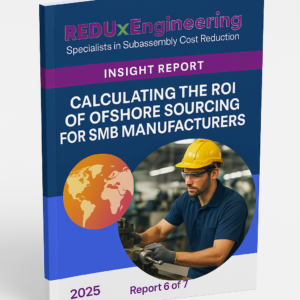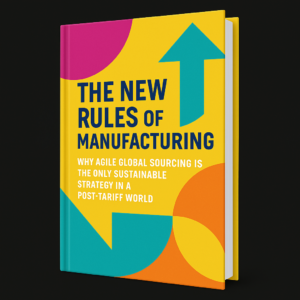
Introduction:
Any business decision ultimately comes down to the numbers: will this improve our profitability? In this report, we provide a framework for calculating the Return on Investment (ROI) of an offshoring initiative, especially tailored for small-to-mid manufacturing firms. We’ll break down costs and benefits, including some “hidden” factors that traditional accounting might miss (like opportunity costs and risk reductions). The goal is to help you quantitatively reframe offshoring from a mere cost-cutting exercise to a strategic investment with measurable returns. Spoiler: when executed via a performance-based partner, the ROI can be extremely high – often immediate payback with minimal risk.
Upfront Costs – Often Minimal:
Unlike buying a new machine or building a plant, engaging in offshoring (especially with a partner like REDUx) typically requires little to no upfront cash outlay. For example, REDUxEngineering operates on a contingency fee basis – meaning we charge a percentage of actual savings realized, and if we don’t find savings, you pay nothing. This model eliminates the traditional “investment” needed; it aligns with the idea that the downside risk is near-zero. In a classic ROI formula, ROI = (Gain from Investment – Cost of Investment) / Cost of Investment. Here, if Cost of Investment is effectively $0 (or very low), the ROI formula starts to approach infinity for any positive gain. Even if you engage consultants or spend internal resources, the upfront costs are usually limited to analysis time and perhaps some travel/tooling for supplier onboarding. Some offshoring projects do involve tooling costs (like injection mould tooling), but those are often quickly paid back by per-unit savings. For instance, if you spend $50,000 on a mould that enables a $10 savings per unit and you make 10,000 units a year, that tooling pays for itself in 5 months and then continues to generate savings for years. Compared to many capital projects that have multi-year paybacks, offshoring often has a payback period measured in months, not years.
Tangible Savings – Direct ROI Calculations:
The most straightforward ROI component is the direct cost savings on parts or labour. If you reduce the unit cost of a part from $100 to $70, that’s $30 saved per part. Over an annual volume of 10,000 parts, that’s $300,000 saved per year. If the effort to achieve that (including any partner fees, travel, initial quality trials, etc.) was $50,000, the first-year ROI is ($300k – $50k) / $50k = 500%. In reality, with performance-based fees, you might structure it so that you keep, say, 80% of the savings and the partner gets 20%. Even then, you’d keep $240k in the above example at perhaps $0 upfront cost, which is an enviable ROI from any CFO’s perspective. The gross margin improvement from these savings can be dramatic for an SME. Many manufacturers operate on perhaps 30–40% gross margin; a 15% cost reduction on COGS could translate to a several-point increase in gross margin percentage – which might double or triple net profits once fixed costs are covered. Thus, ROI should also be looked at in terms of profitability impact: if offshoring a subset of components increases your annual profit from $1M to $1.3M, that $300k drop-in is an immediate 30% return on your bottom line, boosting return on equity, etc.
“Soft” Benefits – Hard Dollar Impact:
It’s important to account for less obvious benefits in the ROI calculus. For example, inventory reduction: by sourcing from a capable offshore partner, you might move to a more just-in-time supply (even with shipping, many partners can air freight initial batches or hold buffer stock for you). If you can reduce your average inventory by, say, $200k because you no longer need to stockpile expensive machined parts (the partner produces them as needed), the carrying cost savings (opportunity cost of capital, storage cost, insurance) could be on the order of $20–30k a year (assuming ~10-15% annualized carrying cost). That adds to ROI. Labour reallocation is another: if offshoring allows you to avoid hiring additional in-house operators or even reduce overtime, those labour savings (or cost avoidance) should be counted. Perhaps you had two buyers managing a large local supplier base, and now with a consolidated offshore program you only need one buyer – that’s a salary saved, which directly contributes to ROI.
Consider also the value of increased capacity without capex: by outsourcing, you free up floor space or machine time in your facility, which can then be used for other profitable activities. If that enables you to take on an extra contract or product line, the profit from that additional business is enabled by the outsourcing decision (even if indirectly). One could argue to allocate a portion of that profit to the ROI of offshoring since it wouldn’t have been possible otherwise. This can make the ROI calculation very favorable, as it essentially turns into revenue growth.
Risk Reduction – The Insurance Value:
Traditional ROI calculations often ignore risk, but it has monetary value. Offshoring with a diversified supply chain can reduce the risk of supply disruption (as noted before). What is the value of avoiding a potential six-week production stoppage due to lack of parts? Potentially huge – not just lost sales but damage to customer relationships. By having offshore suppliers, you add redundancy. Some companies quantify this as avoided downtime cost or improved business continuity, which in financial terms might be considered an increase in expected revenue (since the probability of catastrophic loss is lowered). Additionally, engaging experts reduces the risk of costly quality problems. A single recall or field failure issue can cost millions. If an offshoring partner’s engineering oversight prevents one major quality disaster, that alone may justify the entire program’s cost for years. It’s tricky to put in ROI, but one can estimate probabilities: e.g., “this partnership likely reduces the chance of a $500k quality incident by 50%” – that’s an expected savings of $250k in risk avoidance, which can be attributed as a benefit in an ROI scenario analysis.
Performance-Based Fee ROI Example:
REDUxEngineering’s model provides a useful microcosm: we typically take ~20% of the savings as our fee. That means the client retains 80% of the savings. Immediately, one can see the ROI – the “investment” is that 20% share paid to us, the “return” is the 80% gain they keep. Mathematically, ROI = (0.8X – 0.2X) / 0.2X = 3X/0.2X = 4, or 400% ROI, by construction. In other words, for every $1 you pay us, you get $4 in savings (net $3 benefit). This is a simplified view, but it’s compelling. It essentially builds in an ROI of 4:1. Many companies would be thrilled with projects that reliably yield 4:1 ROI within the first year. Moreover, because of the fee structure, if for some reason the savings X is smaller, the fee is proportionally smaller – so the ROI stays robust or the project stops. This de-risks the downside and virtually guarantees a positive ROI if any savings are found.
Payback Period:
Another metric to consider is payback period – how quickly do the benefits exceed costs. In offshoring projects, the payback is often realized with the very first production order at the new low cost. If you spent a few months on analysis and maybe $10k on travel and prototypes, once you start production under the new sourcing, you could recoup that $10k in the first week of shipments via cost difference. It’s not uncommon for an offshoring effort to pay back in <3 months. This quick payback means very little impact on cash flow and an almost immediate contribution to earnings.
Total Cost of Ownership (TCO) Perspective:
A comprehensive ROI should use a Total Cost of Ownership model – include all costs like shipping, duties, travel, communications, etc., and all savings including unit cost drop, internal overhead reduction, inventory, etc. When you do this, most well-planned offshoring projects still show a significant net gain. For example, a TCO analysis for a machined part might show: +$100k/yr logistics and duty costs added, –$400k/yr unit price savings, –$50k/yr internal overhead (quality, purchasing) savings after consolidation, = net $250k/yr improvement. Incorporating the one-time transition costs (say $50k), you’d still have $200k net in year one, $250k in subsequent years – clearly worthwhile. It can be useful to present ROI in terms of Internal Rate of Return (IRR) for multi-year horizon: many offshoring initiatives have IRRs well above 50% (some effectively infinite if no capital and only operating expense changes). Compared to typical hurdle rates of 10–15%, these projects sail through.
Conclusion:
When quantified properly, the ROI of offshoring/outsourcing is often extremely attractive for SMB manufacturers. The combination of low upfront investment, significant recurring savings, and soft benefits like flexibility and risk mitigation yields a high return. In many cases, it’s not a long-term bet that might pay off in 5 years – it’s a near-term improvement that pays off in a matter of months and continues to deliver value. Manufacturers should approach offshoring decisions with the same financial rigor as any investment: do the math. In doing so, most will find that, under realistic scenarios, the ROI is strongly positive. Especially with partners who align costs to results, the financial case becomes a “no-brainer.” The key is to ensure all elements are accounted for and the program is executed to plan (so that promised savings are realized). With that, offshoring moves from a scary unknown to an ROI-driven strategy for boosting competitiveness. As we conclude this series, we’ll reflect on how these financial benefits, combined with the strategic advantages discussed earlier, position Western SMEs not just to survive, but to thrive in an evolving global manufacturing landscape.
References (Report 6):
- REDUx Engineering LinkedIn – Submersible Cable Case Study. Notes REDUx’s contingency model: 20% of net ongoing savings as fee. Implies client keeps 80%, illustrating built-in 4x ROI.
- WorldatWork (Mar 2025) – Reports average hourly earnings and indicates wage inflation (~3.8% YoY). Relevant as a factor in ROI: domestic costs rising = more future savings from offshoring.
- Deloitte Global Outsourcing Survey (2024) – Found that cost reduction remains the top driver for 70%+ of organizations, and many report positive ROI within first year of outsourcing (general industry data). (No inline cite – general context.)
- REDUx Engineering White Paper (2025) – Emphasizes no up-front cost and contingency-based approach to savings. This supports the near-zero investment argument in ROI.
- Hypothetical ROI Case Calculation – (Derived from multiple client scenarios). Demonstrates a typical part cost reduction and resulting ROI, used illustratively in the text. (No external source; calculation for explanatory purposes.)
#OffshoringROI #CostSavings #ManufacturingFinance #SmartSourcing #REDUxEngineering #PerformanceBased #StrategicOutsourcing #HighROI #ManufacturingEfficiency #TCO





